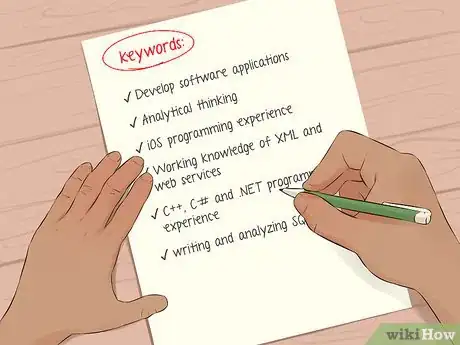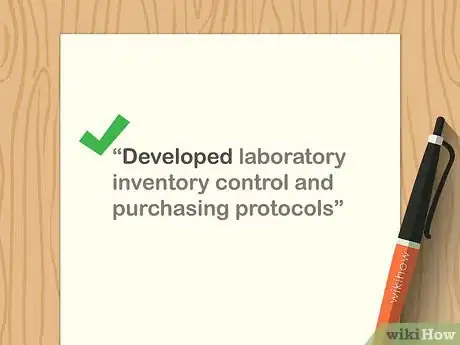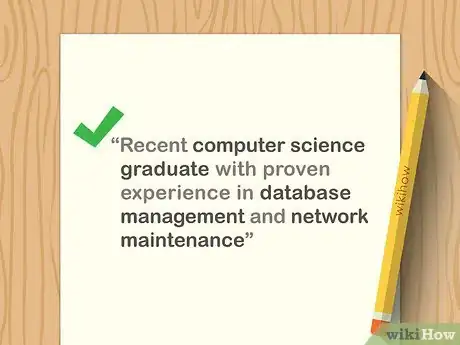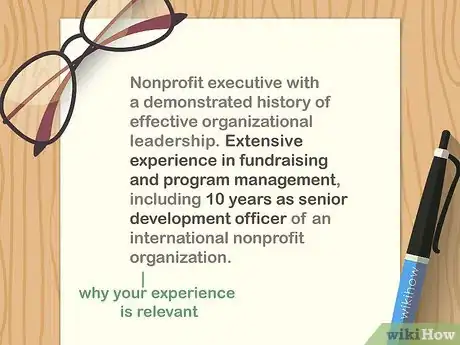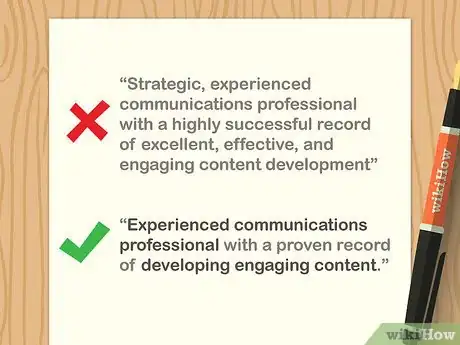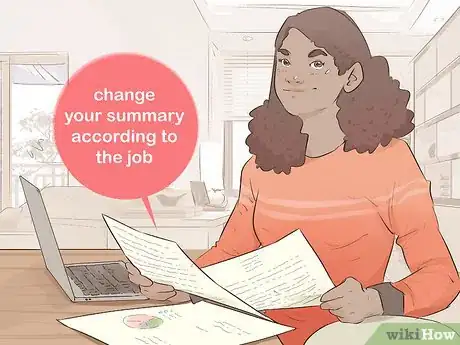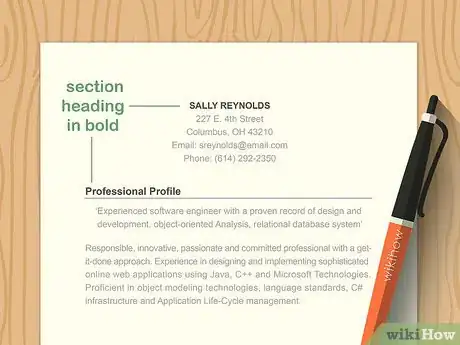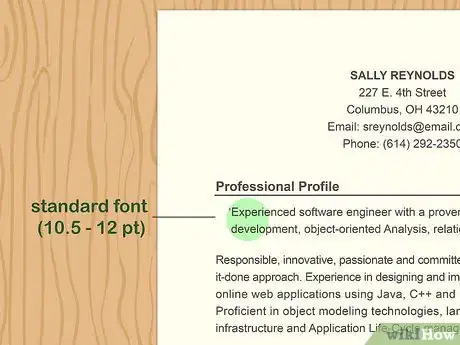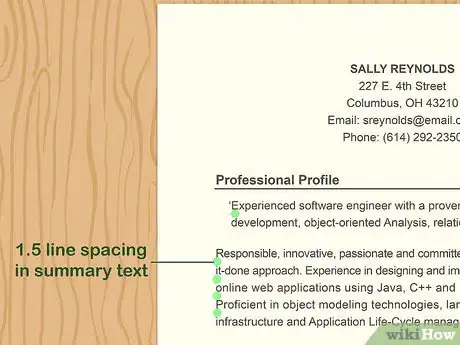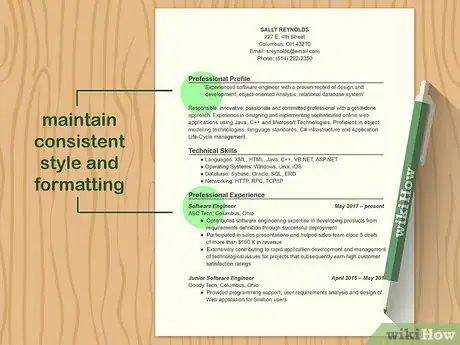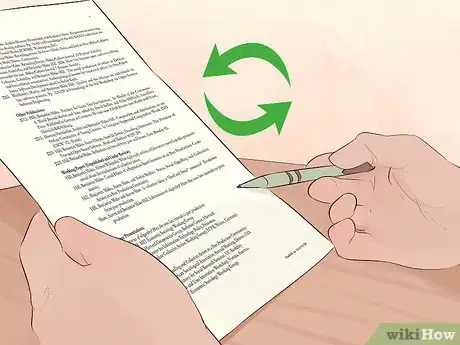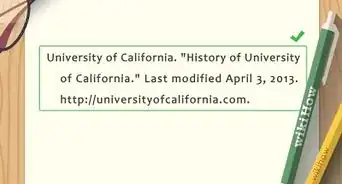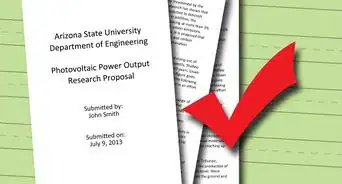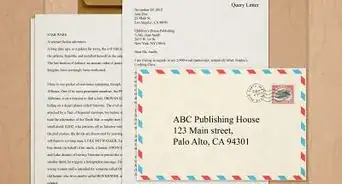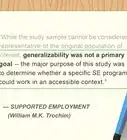This article was co-authored by Katrina Georgiou. Katrina Georgiou is a career coach and the founder of Katrina Georgiou Coaching based in Silicon Valley. Katrina helps individuals find new careers as well as career advancement, including resume writing, interview preparation, salary negotiation, and performance reviews. Trained in the co-active method from the Coaches Training Institute (CTI), Katrina uses personalized communication and leadership strategies to support her clients in building successful and fulfilling careers.
There are 7 references cited in this article, which can be found at the bottom of the page.
This article has been viewed 14,709 times.
Typically longer and more detailed than a resume, a curriculum vitae, or CV, is an overview of your professional and educational history. It’s common to start off a CV with a brief summary that introduces your professional role, skills, and accomplishments. Keep your writing concise, use strong action words, and try to highlight what makes you unique. To give your CV a competitive edge, tweak your summary whenever you apply for jobs to match the specific positions you're applying to.
Steps
Choosing Keywords for Your Summary
-
1Make a list of keywords from your past jobs. Assess your skills and accomplishments, and decide which ones you’d like to highlight.[1] Look over the job descriptions for past positions, and list the responsibilities and skills they mention. These keywords are your summary's raw ingredients, so to speak.[2]
- If you’ve written a resume or CV, review the entries you’ve written for your past jobs, too.
- Examples of keywords include position titles, such as “Marketing Executive” or “Postdoctoral Research Fellow,” and industry-specific hard skills, such as “account management,” “research design,” or “inventory control.”
-
2Check the skills and responsibilities listed in job postings. If you’re applying for a specific position, add the required skills included in the posting to your list of keywords. Be sure to include the position’s title and key skills in your summary and elsewhere on your CV.[3]
- Suppose you’re applying for a position as a medical researcher, and ordering laboratory supplies is a key responsibility listed in the job description. Open your summary with, “Medical researcher with 3 years of experience in laboratory management” to show you have the right experience for the job.[4]
Advertisement -
3Review lists of strong action words. Come up with a bank of action words to string together your skills and accomplishments. Examples include “adept at,” “accomplished,” “developed,” and “implemented.” Other engaging phrases include “proven track record,” “proven success,” “highly skilled at,” and “demonstrated history.”[5]
- For instance, “Developed laboratory inventory control and purchasing protocols” is strong, and tells the hiring manager you know what you’re doing.
- You’ll also need to vary your action words. For example, instead of using “developed” twice in your summary, go for alternatives such as “designed,” “established,” “implemented,” or “revamped.”
Describing Your Experience
-
1Use either the first or third person, but be consistent. You can use the first person if it feels more natural, but avoid including “I” or “me” in every sentence. Whether or not you write in the first person, just be sure your usage is consistent.[6]
- An example of a first person summary would be, “As a publishing executive with 15 years of experience, I have extensive knowledge of editorial planning, international licensing, and brand management.”
- You could also omit personal pronouns and use sentence fragments: “Experienced publishing executive with extensive knowledge of editorial planning, international licensing, and brand management.”
- Just don’t alternate between first and third persons. For instance, avoid writing: “Jane Smith is a publishing executive with over 20 years of experience. I have extensive knowledge of editorial planning, international licensing, and brand management.”
-
2Write a sentence that describes who you are. The first sentence of the summary should describe your professional role. Identify your title, sum up your industry experience, and include 2 to 3 core skills. If you're applying for a job, remember to mention skills that were included in the posting.[7]
- Your summary’s first sentence could be, “Recent computer science graduate with proven experience in database management and network maintenance,” or “Accomplished oncologist with a demonstrated history of translating developments in genomics research into clinical benefit.”
-
3Add a sentence that explains why your experience is relevant. After introducing your professional role, provide further detail in the next sentence. Add context to your experience and explain how you’ve applied your skills. Mention specific projects, accomplishments, or recognition that set you apart from other candidates.[8]
- An example of the 2 sentences put together would be, “Nonprofit executive with a demonstrated history of effective organizational leadership. Extensive experience in fundraising and program management, including 10 years as senior development officer of an international nonprofit organization.”
-
4Cut lengthy descriptions or fluff. Your summary should be between 50 and 200 words, or around 2 to 3 lines.[9] You don’t have room in the summary or elsewhere on your CV for fluff, so try to be concise. Describe your experience using meaningful, specific words, and avoid using vague buzz words just for the sake of it.[10]
- For instance, “Strategic, experienced communications professional with a highly successful record of excellent, effective, and engaging content development” is too wordy. Better phrasing would be, “Experienced communications professional with a proven record of developing engaging content.”
-
5Tailor your CV for every application.[11] Think of your CV as a living document. Each time you apply for a job, read the posting carefully and note the key skills it lists. Plug those skills into your summary and entries listed in your experience section.[12]
- Suppose a job posting lists personnel management as a required skill, and your summary doesn’t mention anything about your leadership skills. Add information about any time you’ve led a team or managed a staff to make it clear you meet the job’s requirements.
Formatting Your Summary
-
1Place the summary at the top of your CV after your contact information. Skip a line between your contact info and the summary section heading. Use the summary to get your CV off to a strong start and preview the rest of its content.[13]
- Think of the summary as an elevator pitch. It’s a clear, concise statement that explains who you are and what you bring to the table.
-
2Type the section heading in bold or caps. If you’ve already formatted other section headings, such as “Relevant Experience” and “Education,” type the summary heading in the same style. Title the section “Professional Summary,” “Professional Profile,” or simply “Summary.”[14]
Tip: Good formatting options for section headings include bold, writing in all caps, and setting the font size 1 to 2 points larger than the main text.
-
3Use a readable font set at 10.5 to 12 point. Sans serif fonts, such as Arial and Helvetica, are generally easier to read than serif options, such as Times New Roman or Georgia. Go with a font size no smaller than 10.5 for the summary and your CV's other body text.[15]
- A smaller font would be tough to read and make your resume look cluttered.
- Serif fonts have small lines at the ends of the strokes in letters and symbols, which can make text harder to skim.
-
4Include 1.5 line spacing in your summary text, if possible. If you have enough room, add some space between your summary’s lines to improve readability. Your summary will likely be the longest continuous block of text on your CV. If it’s single-spaced, the text might feel squeezed-in and overwhelming.[16]
- If you don’t have enough room to space the summary text at 1.5, go to your word processing program’s custom spacing options. Play around with settings between 1 and 1.5 to find one that works.
-
5Make sure your formatting and style are consistent. Review your section headings, line spacing, font sizes, and other formatting elements. Double check that you’ve written date ranges, position titles, and descriptions consistently throughout your CV.[17]
- For instance, avoid writing “June 2015 — April 2018” in one entry but “6/12 through 6/15” in another. Inconsistent formatting sticks out like a sore thumb and could make hiring managers think you lack attention to detail.
-
6Proofread your CV carefully. Your CV or resume needs to be completely free of spelling and grammatical errors. Check and double check your work for typos or mistakes until you’re 100% certain that your spelling and grammar are perfect.[18]
Proofreading Tips
Set your CV aside for a few hours before proofreading it. You might have an easier time checking for spelling and grammar errors with fresh eyes.
Read your CV out loud when you proofread. Reading out loud can help you spot errors and make sure your phrasing sounds natural.
Watch out for hard-to-spot errors. For instance, using “lead” instead of “led” is a common and often overlooked resume error.
-
7Ask a mentor, coworker, friend, or relative to review your CV. At a minimum, have someone with excellent spelling and grammar skills proofread your resume. If you know someone who has a lot of experience in your field, ask them to offer feedback on your CV’s content and structure.[19]
- Additionally, send your CV to anyone you’ve asked to be a reference. That way, they can highlight your specific achievements if they’re asked to discuss your credentials.
Community Q&A
-
QuestionHow do you write a career summary for a CV?
 Katrina GeorgiouKatrina Georgiou is a career coach and the founder of Katrina Georgiou Coaching based in Silicon Valley. Katrina helps individuals find new careers as well as career advancement, including resume writing, interview preparation, salary negotiation, and performance reviews. Trained in the co-active method from the Coaches Training Institute (CTI), Katrina uses personalized communication and leadership strategies to support her clients in building successful and fulfilling careers.
Katrina GeorgiouKatrina Georgiou is a career coach and the founder of Katrina Georgiou Coaching based in Silicon Valley. Katrina helps individuals find new careers as well as career advancement, including resume writing, interview preparation, salary negotiation, and performance reviews. Trained in the co-active method from the Coaches Training Institute (CTI), Katrina uses personalized communication and leadership strategies to support her clients in building successful and fulfilling careers.
Career Coach In order to write a strong career summary, it’s helpful to understand your key skills and which of those are relevant to the position you're applying for. The summary should be brief, no more than two-three sentences. Done successfully, you will mirror your work experience to the particular position, highlighting the skills you have mastered to clearly define that you are a fit for the target roles.
In order to write a strong career summary, it’s helpful to understand your key skills and which of those are relevant to the position you're applying for. The summary should be brief, no more than two-three sentences. Done successfully, you will mirror your work experience to the particular position, highlighting the skills you have mastered to clearly define that you are a fit for the target roles. -
QuestionAm I able to have a job while still studying at high school?
 Tom De BackerTop AnswererIf you have some time to spend on this job, as agreed with your employer, then all that remains is to find an employer willing to hire you. So yes, you can do this.
Tom De BackerTop AnswererIf you have some time to spend on this job, as agreed with your employer, then all that remains is to find an employer willing to hire you. So yes, you can do this.
References
- ↑ Katrina Georgiou. Career Coach. Expert Interview. 25 June 2020.
- ↑ https://www.careereducation.columbia.edu/resources/how-write-resume-profile-or-summary-statement
- ↑ https://www.careereducation.columbia.edu/resources/how-write-resume-profile-or-summary-statement
- ↑ https://hbr.org/2014/12/how-to-write-a-resume-that-stands-out
- ↑ https://studentaffairs.duke.edu/career/resume-cv-guide#expand-accordion-7490
- ↑ https://www.theguardian.com/careers/careers-blog/how-to-write-a-personal-statement-for-your-cv
- ↑ https://www.theguardian.com/careers/careers-blog/how-to-write-a-personal-statement-for-your-cv
- ↑ https://studentaffairs.duke.edu/career/resume-cv-guide#expand-accordion-7490
- ↑ Katrina Georgiou. Career Coach. Expert Interview. 25 June 2020.
- ↑ https://www.careereducation.columbia.edu/resources/how-write-resume-profile-or-summary-statement
- ↑ Katrina Georgiou. Career Coach. Expert Interview. 25 June 2020.
- ↑ https://www.apa.org/gradpsych/2015/01/curriculum-vitae.aspx
- ↑ Katrina Georgiou. Career Coach. Expert Interview. 25 June 2020.
- ↑ https://studentaffairs.duke.edu/career/resume-cv-guide#expand-accordion-7490
- ↑ https://ocs.fas.harvard.edu/files/ocs/files/gsas-cvs-and-cover-letters.pdf
- ↑ https://www.theguardian.com/careers/careers-blog/how-to-write-a-personal-statement-for-your-cv
- ↑ https://www.theguardian.com/careers/careers-blog/how-to-write-a-personal-statement-for-your-cv
- ↑ https://www.apa.org/gradpsych/2015/01/curriculum-vitae.aspx
- ↑ https://hbr.org/2014/12/how-to-write-a-resume-that-stands-out
- ↑ https://ocs.fas.harvard.edu/files/ocs/files/gsas-cvs-and-cover-letters.pdf
